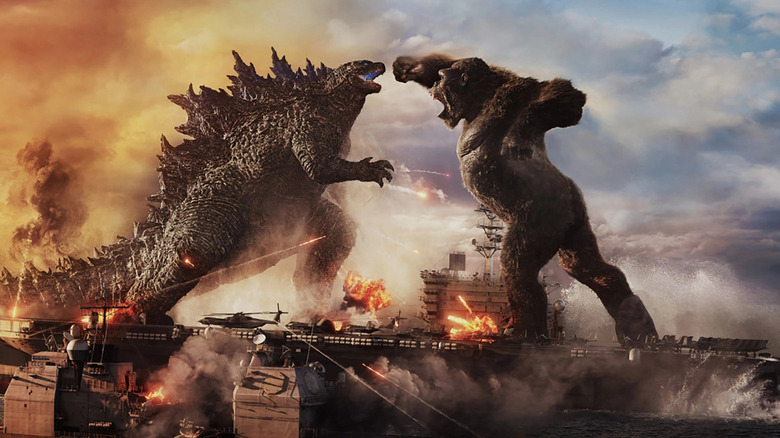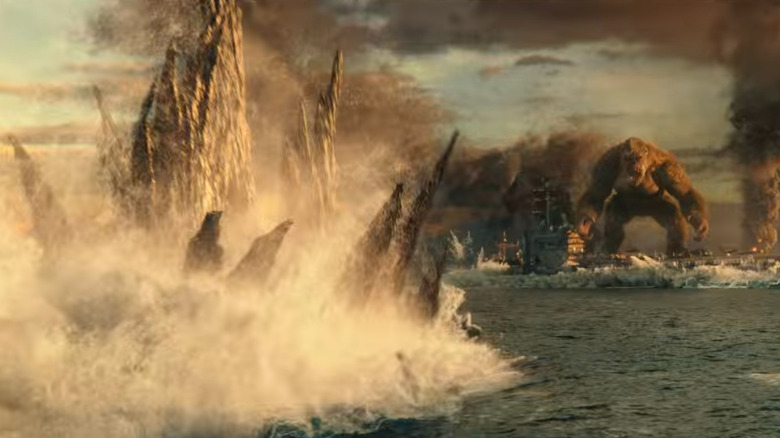Adam Wingard Had To Do Some Real-Life Science To Prove Godzilla Vs Kong's Biggest Fight Could Happen
Lampoon the idea of a hollow earth all you want, but let it never be said that the kaiju battle aboard an aircraft carrier in "Godzilla vs. Kong" is scientifically inaccurate. Adam Wingard was coming from a horror background when he signed on to direct the sequel to both "Kong: Skull Island" and "Godzilla: King of the Monsters," and while a creature feature would seem to be right up his alley, this was a giant monster movie, told on a blockbuster scale that Wingard had yet to operate on. There were a lot of practical things to consider, not the least of which is whether it would even be possible for King Kong and Godzilla to fight on top of an aircraft carrier in the middle of the ocean without it sinking.
The real meat of the aircraft carrier fight lasts all of 30 seconds in "Godzilla vs. Kong," but it furnished the movie with the indelible promo image of Kong punching Godzilla in the face at sea (a shot that almost didn't make the cut). In a 2021 interview, Wingard related how that shot evolved out of a vague description that initially left him questioning the physics of two oversized monsters duking it out on an aircraft carrier. He told RogerEbert.com:
"So I'm reading the proposal and it gets to all the action scenes, and it gets to the ship battle. And it's very vague: 'Here we are at the ship battle, you're going to see Kong do things you've never seen him do before, he's going to jump from ship to ship, Godzilla and Kong fight on an aircraft carrier, it's going to be amazing.' And that's basically how we left it. And the first thing I thought was, 'Can Godzilla and Kong fit on an aircraft carrier?'"
'The math works'
The aircraft carrier fight begins about 43 minutes into "Godzilla vs. Kong," as the King of Monsters clambers up onto the ship's deck and Kong clocks him. Godzilla gets in a good shot where he claws Kong onto his back, powering up his blue atomic breath before some jet fighters hit him with explosions from behind. Kong recovers and decks Godzilla a couple more times, knocking him off the ship, but it manages to hold steady the whole time despite the massive weight of the two monsters.
Wingard conceded that viewers don't "seek these movies for the ultimate depiction of reality," but he went to great lengths to ensure that the aircraft carrier fight didn't "strain credibility so far." As he explained, this involved running some tests with production designer Tom Hammock, who assembled a guide showing that a 1,000-foot aircraft carrier could conceivably hold two 300- to 350-foot beasts of Godzilla and Kong's size in the Monsterverse. Wingard continued:
"The next step was the art department people—they put together a size test of some kind, and so obviously there's no way to actually measure how heavy Godzilla and Kong are, but estimating the amount of space they take up and the size, the weight that they have together, versus the weight of what an aircraft carrier can supposedly handle, it worked. The math works."
Many things in life are uncertain, but at least now we can all rest knowing that kaiju dust-ups aboard aircraft carriers are possible. Whoever told you your eighth-grade science project centered on a hypothetical monster battle was a waste of time clearly doesn't know a thing about the way Hollywood works.

